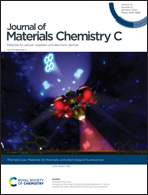Recent progress of sulphur-containing high-efficiency organic light-emitting diodes (OLEDs)
Abstract
In the last few decades, organic light-emitting diodes (OLEDs) have been rapidly developed and occupy an important position in the lighting and display market. Early conventional fluorescent OLED materials can only utilize 25% of excitons. Improving the harvest of non-emissive triplets has become the most important issue in this field. Organic electroluminescent materials have been developed from the first generation of fluorescent materials to the second generation of phosphorescent materials, and to the new generation of luminogens, mainly including triplet–triplet annihilation (TTA) materials, thermally activated delayed fluorescence (TADF) materials and hot exciton materials. The new generation of luminogens is mainly constructed using heterocyclic compounds with a D–A structure. Sulphur-fused heterocyclic derivatives are some of the most investigated heterocyclic compounds. Sulphur possesses two lone pairs of electrons and an empty d orbital with an outermost electron structure of 3s23p4. Sulfoxide or sulfone with electron-deficient characteristics can be easily formed by oxidation of sulphur, which is beneficial to electron injection and transportation. All these features make sulphur-fused heterocyclic derivatives an appealing building block for the new generation of luminogens. Herein, recent progress of efficient OLEDs based on sulphur-containing heterocyclic compounds, involving thiophene, phenylsulfone, thiazole and phenothiazine, as the active layers, is systematically summarized. The fundamental principles regarding molecular design are discussed, and representative reported TADF and hot exciton sulphur-based luminogens are summarized and analyzed, along with their structure–property relationships and OLED applications. As a structure/property/device performance relationship map is drawn, it is hoped that the review indicates one way to obtain better performance of this series of promising OLEDs.

- This article is part of the themed collections: Journal of Materials Chemistry C Recent Review Articles and Materials for thermally activated delayed fluorescence and/or triplet fusion upconversion


 Please wait while we load your content...
Please wait while we load your content...